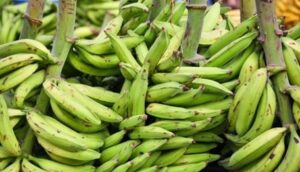Starch has always been part of our food. It was a major component in ancestral diets and it is still a major in today’s food. Starch-based foods constitute the five largest food crops around the world: maize, wheat, rice, potatoes, and bananas. Notwithstanding stories and claims by advocates of the Paleolithic and other “caveman” diets, people have always consumed starchy foods.
After reading this important article and conducting extensive studies on resistant starch diets on our health, I realized that we have been lied to that starchy foods are not good for our health. I had to readjust my diet after reading about the numerous benefits of resistant starch. The resistantstarchresearch.com article on resistant starch which I am reproducing here is worth reading:

Green plantain and Green Banana contains over 80percent of resistant starch.-Type 2
Resistant starch, therefore, has always been part of our diet. It has been estimated that 4-10percent of starch in foods resists digestion and reaches the large intestine. (Cassidy 1994). Intact whole grains and raw starches are excellent sources of Type 1 and Type 2 resistant starch. Intact and coarsely ground grains contain a significant amount of resistant starch because the attached plant material encases the starch and slows down its digestion.
With milling, the particle size of the grains is reduced, the protective barrier is removed and the amount of resistant starch is greatly diminished, as the starch becomes more easily digested. Thus, intact whole grains contain resistant starch but refined whole grains do not. Cooked and cooled starchy foods also provide Type 3 retrograded resistant starch. (See the FAQ for additional information on the types of resistant starch.)

Maize diets (Banku, Kenkey etc) can be found in type 3 resistant starch
Historically, people ate 30-50 grams of resistant starch per day. Instead of an abundant quantity of hard-to-digest carbohydrates, most of today’s carbohydrates are high glycemic and easily digestible. This was a marketing pitch in the 1940s – New Era Scientifically Processed Potato Chips advertised that they were “more readily digested”.
In the 1940s, more digestible food was seen as a benefit!
These marketing campaigns worked as people steadily moved to the convenience and ease of processed foods. Today, people consuming today’s Western-style diets typically consume only 3-8 grams of resistant starch per day. (Platel 1994, Brighenti 1998, Liljeberg 2002, Murphy 2008). Resistant starch intake in Chinese adults was calculated to be higher at 14.9 grams/day with cereal and tuber products contributing the most. (Chen 2010)
Over the centuries, our diet of slowly digestible and resistant starch became more and more digestible. Now, we are discovering the detrimental health consequences of this shift in our starch consumption.
Starchy foods in history
There is an abundant amount of data supporting ancestral starch. The Neanderthals in France used tools to dig starchy roots out of the ground and regularly consumed these starchy foods approximately 125-250,000 years ago. (Hardy 2011). Food residues from Upper Paleolithic sites dated 30,000 years ago show that the grinding of starchy roots and rhizomes into flours and foodstuffs was common practice. (Jaminet, p. 11) Our hominid ancestors were eating savanna tubers, roots, and corms – foods similar to our modern potato and taro. (Yeakel 2007)
Australian Aboriginal bushfoods contained numerous roots, corms, nuts, and tubers, including long yam, cheeky yam, native arrowroot, and bush potato. When prepared through traditional methods, these foods were more slowly digested and contained more resistant starch compared to Western foods commercially available today. (Thorburn 1987)

Yams contain resistant starch
Pacific Islander foods included breadfruit, taro, and sweet potatoes. (Thorburn 1987) Yams, a staple food in the South Pacific islands for thousands of years, were typically peeled, boiled, and mashed, or dried and ground into a powder that could be cooked into a porridge. (Tedder 1974).

Cocoyams- Resistant Starch diet
Natives of Mexico farmed corn as early as 5000 B.C., and shortly after, beans and squash. (Schenone 2003) The oldest known cobs of maize were discovered in Bat Cave, New Mexico, and are believed to have been laid there since 3600 B.C. Maize, beans, and squash were planted together around 800 A.D. in what is now known as Illinois. These “Three Sister” crops provided surplus food that created an expanded population throughout the extended Mississippi River valley and tributaries, for hundreds of years. Their importance to American agriculture was commemorated on the 2009 Native American US$1 coin.
Traditional African diets have long included a stiff porridge. This porridge was usually made with sorghum or millet before the sixteenth century when corn (maize) found its way from the Americas to Africa (Maize & Porridge). Today, maize porridge remains a staple in traditional African diets. It is known by many names, including nshima in Zambia, ubwali in Bemba, sadza in Zimbabwe, and ncima in Mozambique.
Often, it is cooked in the morning and eaten throughout the day and is rich in retrograded resistant starch (RS Type 3). A recent clinical study reported that traditional South African diets contain 28 grams/day of dietary fiber plus an estimated 38 grams of resistant starch/day through foods such as putu, a maize porridge. (O’Keefe 2015).

Maize porridge when cooled belongs to type 3 resistant starch diet
Wild potatoes originated in the Andes mountains of South America – they were domesticated and cultivated approximately 7,000-10,000 years ago and provided a principal energy source for the influential Inca civilization. Not only did the Incans use potatoes as a staple crop, but they also dehydrated them and used it as a rescue food in case of crop failure. (Chapman) Potatoes were introduced to Europe in the second half of the 16th century by the Spanish. They helped to stabilize access to food.
For instance, in France, before the widespread adoption of potatoes, French farmers were barely able to feed the population, with at least 40 outbreaks of serious, nationwide famines between 1500 and 1800. Potatoes produced more food per acre than wheat, survived the destruction of above-ground crops by soldiers during wars, and were used as insurance against crop failure. By the end of the Napoleonic Wars in 1815, the potato had become a staple food in the diets of most Europeans. (Chapman).











